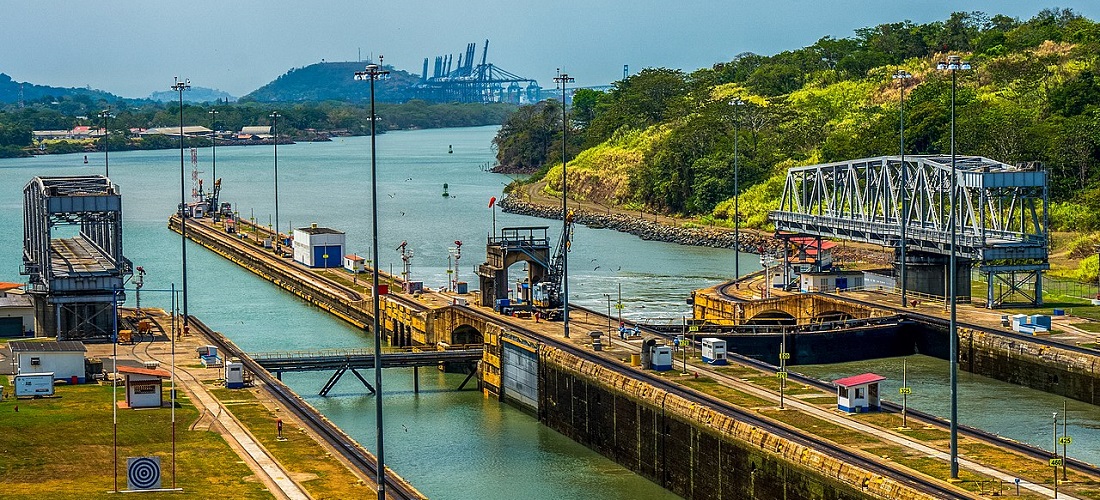
Climate change represents risks for the future of Panama Canal
Jun, 05, 2023 Posted by Gabriel MalheirosWeek 202323
The Panama Canal connects the Atlantic Ocean to the Pacific, forever changing the history of global shipping. Before the canal was completed, ships had to go around the southern tip of South America, a much longer and more dangerous route.
For centuries, the sea surrounding the stormy Cape Horn has been notorious as a ship graveyard, claiming the lives of thousands of sailors and countless vessels. However, the advent of the Panama Canal brought about a significant change by reducing the journey by over 13,000 kilometers, resulting in time and cost savings.
Yet, this critical route now faces a new threat: climate change. The opening of the canal’s locks releases millions of gallons of freshwater into the sea, causing a drop in water levels within the canal. While this water is eventually replenished, the impact of climate change has led to a decrease in rainfall across Central America. Consequently, residents, conservationists, and meteorologists have noticed a decline in available water for the canal. If the freshwater supply from the locks becomes inadequate, it will increasingly hinder the passage of large ships.
But where does that much water come from?
The reason behind the Panama Canal’s substantial freshwater usage lies in the need to navigate through a dozen locks that elevate or lower ships by 26 meters. According to Everstream, a consulting firm monitoring supply chains for international companies, each ship passing through the canal requires approximately 200 million liters of water.
As the entity responsible for operating the canal, the Panama Canal Authority has recently implemented strict draft restrictions. The draft of a ship refers to the distance between its waterline and the bottom, determining the necessary water depth for safe navigation. A loaded ship with heavy cargo will have a greater draft, sinking deeper into the water.
Under normal conditions, the canal operates with a draft of 15.24 meters. However, in early May, officials adjusted the draft limits for Neo-Panamax locks, which accommodate some of the largest ships using the canal, based on projected water levels. As of May 24, these ships will be limited to a draft of up to 13.56 meters, with a further reduction to 13.4 meters on May 30.
Adding to the severity of the situation, analysts at Everstream anticipate that the conditions will not improve until late spring, possibly worsening the challenges faced by the shipping industry.
Hamburg-based shipping company Hapag-Lloyd and other international carriers have responded by loading fewer containers to reduce their ships’ draft. However, to offset the resulting revenue loss, Hapag-Lloyd plans to introduce a $500 surcharge per container passing through the Panama Canal, effective from June. Experts in the trade industry express concerns about disruptions to supply chains and extended transport times, ultimately impacting prices.
Not everyone is scared
Vincent Stamer boasts a more relaxed stance on the water levels in the Panama Canal and the potential consequences for global trade. “It won’t be really critical for supply chains for now,” the Kiel-based economist at the Institute for the World Economy (IfW) told DW.
It won’t be like in 2021, when the Ever Given freighter jammed and blocked the Suez Canal. “The Panama Canal is not as important to the global economy as the Suez Canal,” explained Stamer. In addition, 90% of world trade is handled by the world’s oceans which have shown a relatively pronounced resilience in recent years, according to the expert. “After the multiple strains caused by ship congestion, port closures, and blockades in recent years, supply chains have recovered significantly,” he noted.
Source: Opera Mundi
To read the original news report, see: https://operamundi.uol.com.br/meio-ambiente/81038/como-clima-impacta-canal-do-panama-e-cadeias-de-suprimentos
-
Ports and Terminals
Oct, 29, 2021
0
Containerized cargo handling increases 13% at the Port of Paranaguá in 2021
-
Other Logistics
Jan, 15, 2019
0
ANTT goes ahead with Ferrogrão railway vote without consulting indigenous people
-
Ports and Terminals
Jun, 07, 2023
0
Working groups gather funding strategies to secure Babitonga Bay dredging
-
Trade Regulations
Mar, 04, 2024
0
Brazil sees lost ‘window of opportunity’ in closing Mercosur-EU trade agreement



